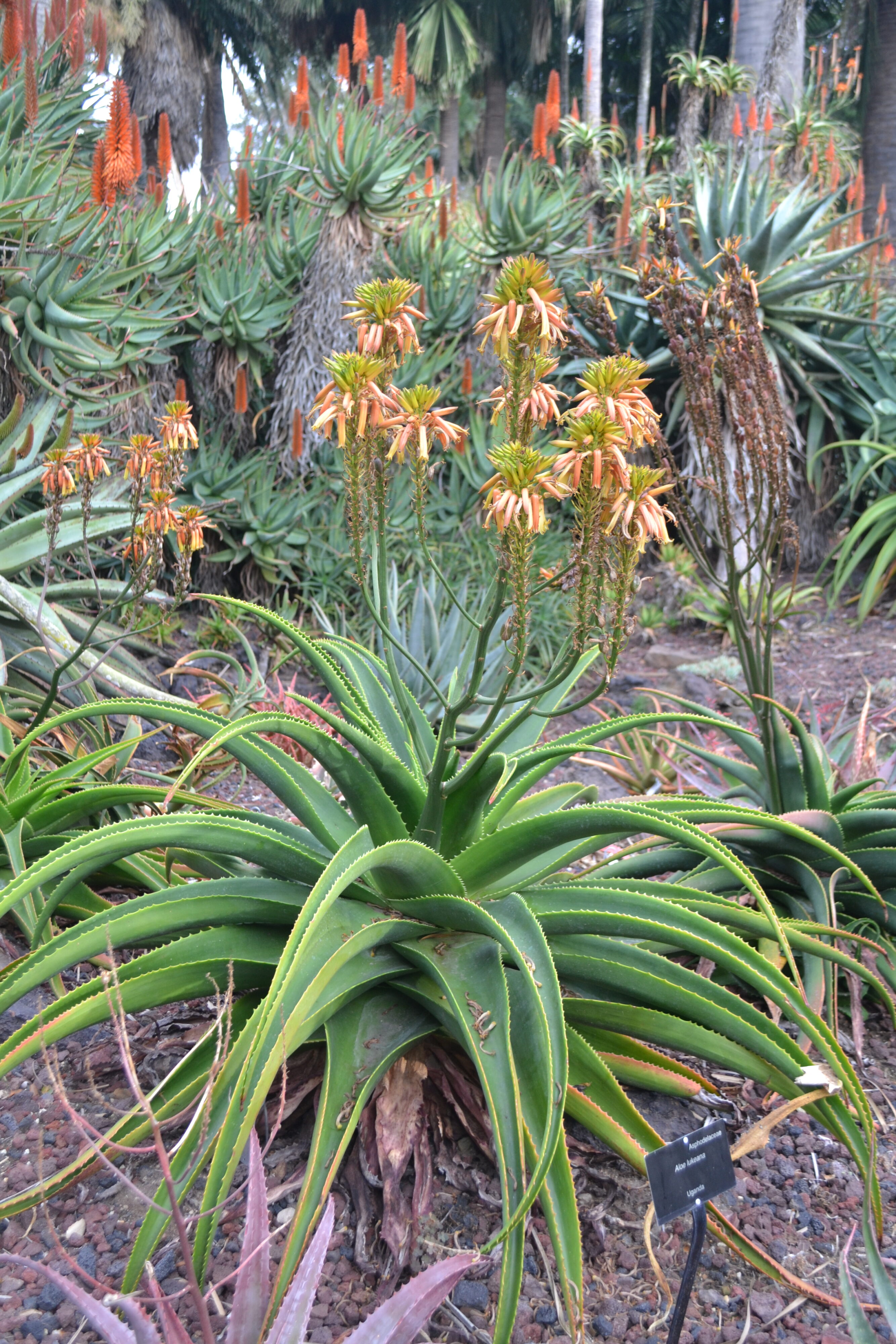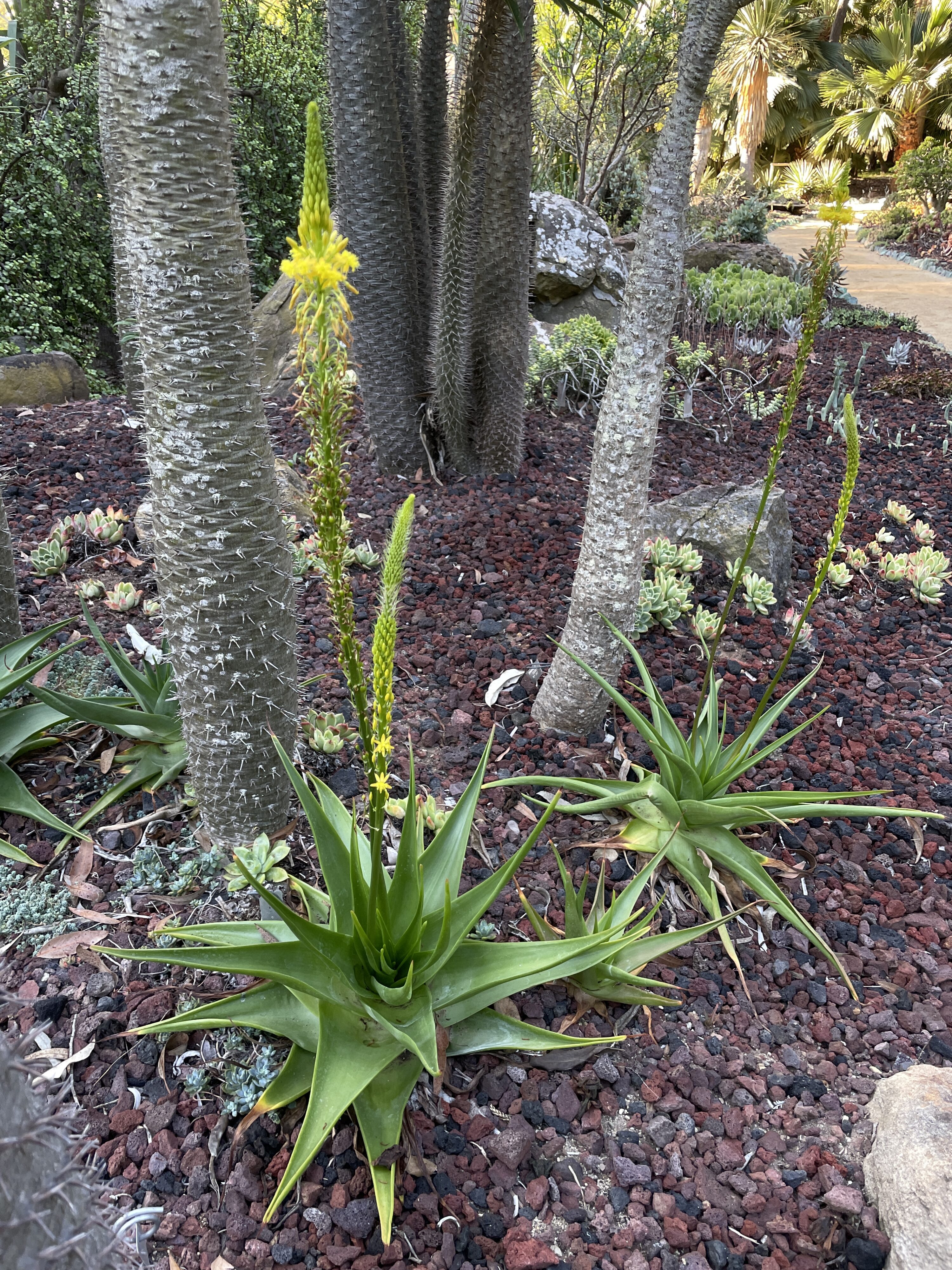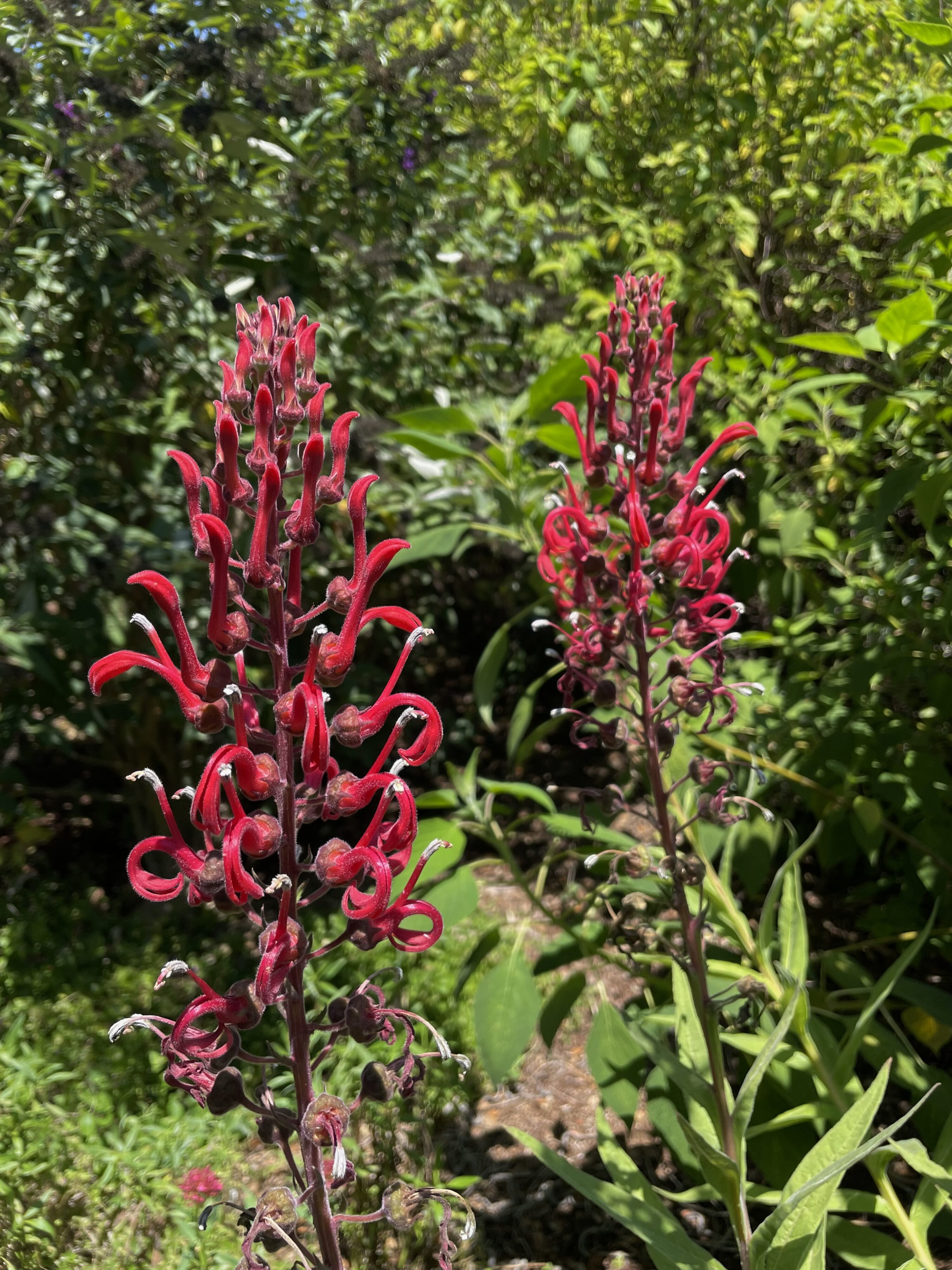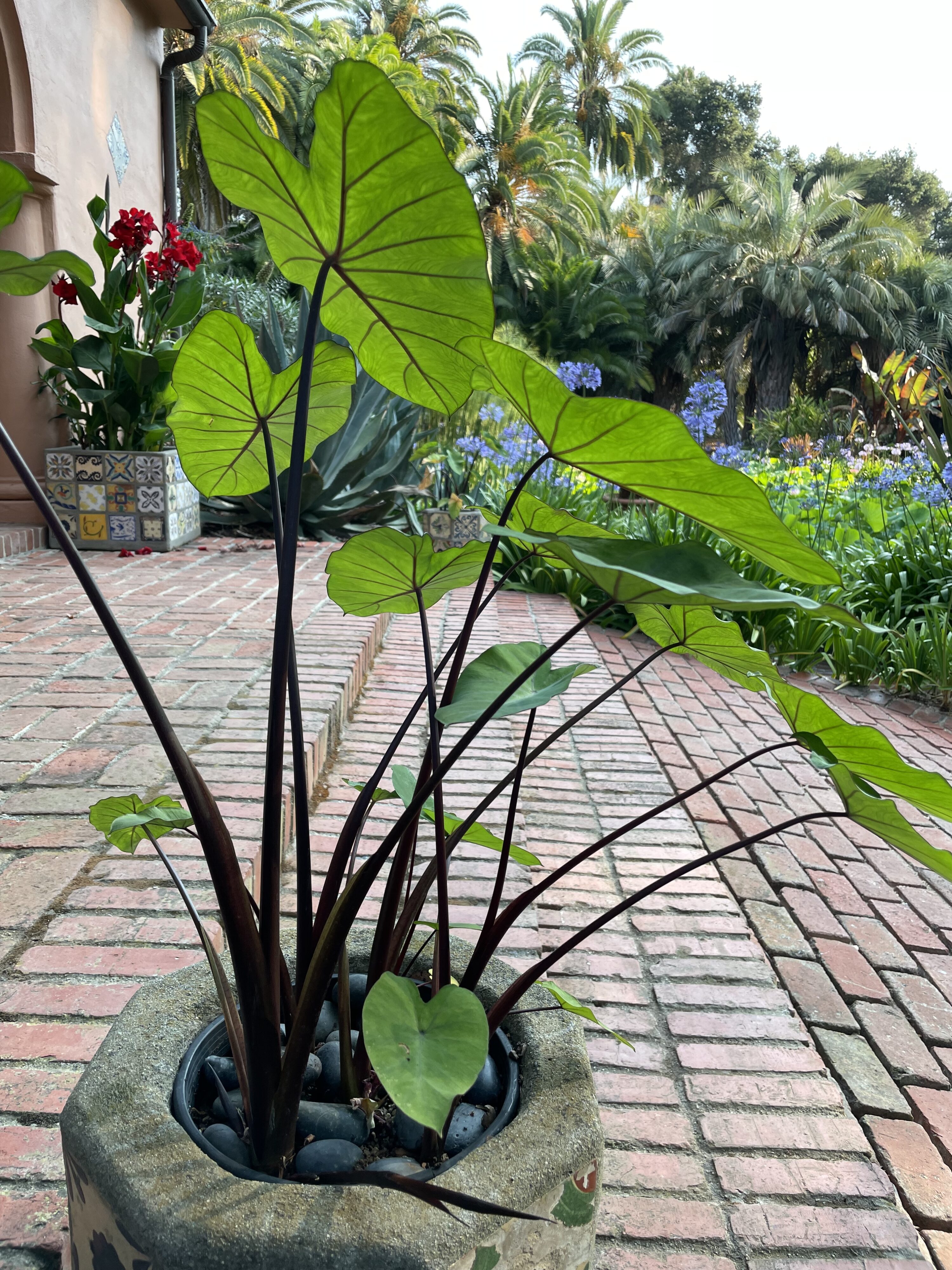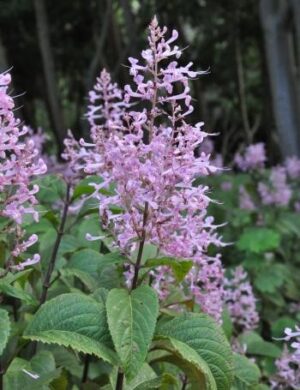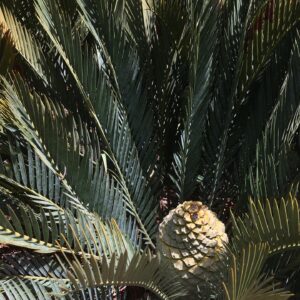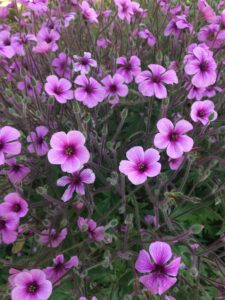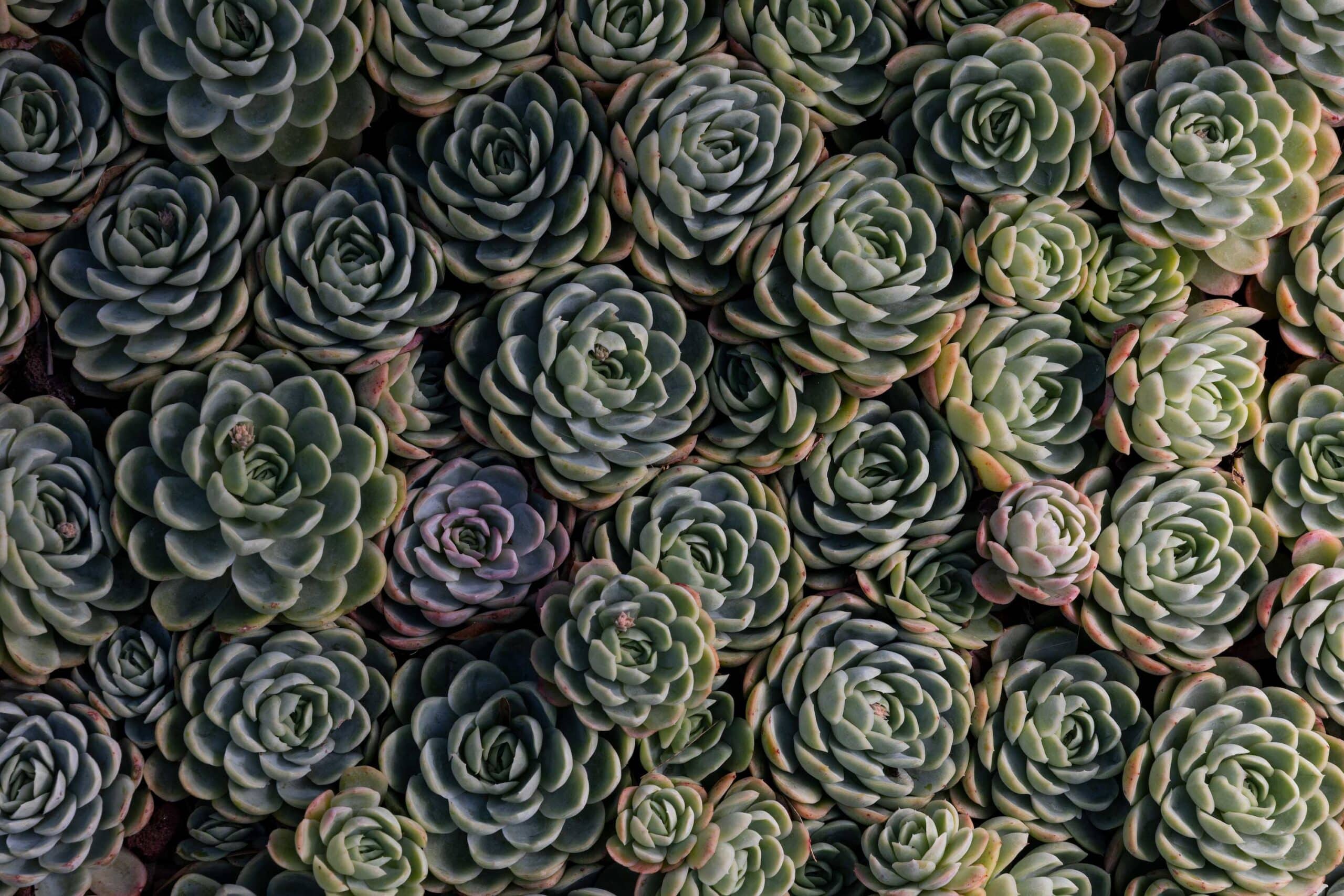
Plant Highlights
Plant Highlights
-
Furcraea macdougallii
MacDougall’s century plant
Highlight Month:
April
Nativity:
This Mexican Agave relative is native to Oaxaca, Chiapas, and Puebla where it grows in dry forests at elevations of 2,600 to 3,300 feet.
Growth Habit:
Mature F. macdougallii form a swollen trunk up to 15 feet tall topped with a rosette of thick dark green leaves reaching 7’ in length with curved marginal teeth. This species is monocarpic and will die after flowering. However, the dramatic 20’ inflorescence produces hundreds of bulbils (small plantlets) that can be easily propagated as clones of the parent plant.
Growing Requirements:
This species prefers full sun and has very low water needs.
Features:
F. macdougallii was first described by Eizi Matuda, a Japanese-born Mexican botanist who named this plant in honor of his friend Thomas MacDougall, a Scottish naturalist who studied southern Mexican flora for almost 50 years. MacDougall is credited with discovering this plant in the wild near Tehuantepec in Oaxaca.
Where at Lotusland:
At Lotusland there are three specimens of F. macdougallii near the intersection of the Succulent Garden and Blue Garden. These plants were donated to Lotusland from the International Succulent Introductions (ISI) 1965 distribution via the UC Santa Barbara Greenhouses and planted in 1995.
-
Aloe lukeana
Luke’s aloe
Highlight Month:
February
Nativity:
Aloe lukeana is found in northeastern Uganda and South Sudan.
Growth Habit:
It displays striking red to orange flowers in late summer-early winter that are held upright before becoming pendant. This large solitary Aloe will reach 3-4’ wide and form a decumbent rosette that grows along the ground. This species is relatively new to cultivation but observations in the wild indicate it eventually forms an upright trunk and may branch with age.
Growing Requirements:
Well-drained soils and full sun.
Features:
This Aloe was first described in 2015 by Tom Cole, owner of Cold Spring Aloes, humanitarian/agricultural aid worker, and Lotusland neighbor. It is named in honor of his late brother, Luke Cole, an environmental justice lawyer and conservationist who tragically died while exploring Uganda in 2009.
Where at Lotusland:
Aloe Garden
-
Citrus x junos
yuzu
Highlight Month:
January
Nativity:
Yuzu is an East Asian citrus believed to have originated in central China as a hybrid of Citrus reticulata var. austere (a mandarin orange variety) and Citrus cavaleriei.
Growth Habit:
It is one of the more cold-hardy citrus species and can withstand temperatures down to 10°F. The leaves exhibit a unique broad petiole below the leaf blade and the stems have thorns.
Growing Requirements:
Adaptable to various climates, from tropical to subtropical and Mediterranean. Provide supplemental water throughout the growing season and during dry months.
Features:
There are many varieties of yuzu: hana yuzu (“flower yuzu”, grown ornamentally for its flowers); yuko (a rare yuzu with sweet flesh), and shishi yuzu (“lion yuzu”, grown for its thick knobby skin). The highly fragrant rind and bitter juice are used for drinks and cooking and the essential oils are added to perfumes, lotions, and soaps. Fruits can be used when unripe (green) or ripe (yellow). Yuzu is the main ingredient in yuja-cheong, a Korean marmalade that serves as a base for hot tea. In Japan, whole yuzu fruits are traditionally added to hot baths on the winter solstice.
Where at Lotusland:
Citrus Orchard
-
Bulbine natalensis
broad-leaved bulbine, rooiwortel
Highlight Month:
October
Nativity:
This plant is native to KwaZulu-Natal in eastern South Africa where it grows on sandstone cliffs and dry river valleys. It is considered a pioneer species in habitat and will readily colonize disturbed areas.
Growth Habit:
Bulbine natalensis is a soft, spineless succulent that resembles an Aloe. It forms solitary rosettes about 1’ wide and flowers in the late winter/early spring. Flowers are yellow, lightly fragrant, and are held on an unbranched inflorescence 1-2’ above the main rosette. The filaments of the stamens are bearded, making the flowers appear fuzzy.
Growing Requirements:
It is easy to grow in well-draining soil in full sun. Plants usually live for 5-8 years but will seed around the garden.
Features:
The Afrikaans common name for this plant is rooiwortel (red root) in reference to the orange/red color of the lower stem when it is damaged and exposed to light. The sap of this plant is used medicinally and as an aphrodisiac and testosterone booster.
Where at Lotusland:
Bulbine natalensis can be found in the Succulent Garden at Lotusland growing below the Pachypodium.
-
Microgramma vacciniifolia
Highlight Month:
September
Nativity:
M. vacciniifolia is native to moist/wet forests in tropical America (Venezuela and Columbia to Paraguay and Argentina) where it grows as an epiphyte (on other plants) or lithophyte (on rocks).
Growth Habit:
This fern displays attractive long rhizomes covered in brown scale-like hairs and dimorphic fronds. Fertile fronds are slender and develop sori (spore case clusters) on the underside whereas sterile fronds are round-ovate and do not play a direct role in reproduction.
Growing Requirements:
This fern performs well in hanging baskets, terrariums, and can be mounted to pieces of bark. In more arid climates, cultivation may be more successful in the ground where the humidity is higher. It can tolerate brief periods of 30-40°F but is considered tender to semi-tender.
Features:
The genus Microgramma is derived from the Greek mikros (small) and gramme (line), referring to the elongated sori of other members in the genus. Vacciniifolia references leaves in the shape of those in the genus Vaccinium (which includes blueberries, cranberries, and huckleberries).
Where at Lotusland:
This unusual and uncommon fern can be found in Lotusland’s Fern Garden growing in a hanging basket.
-
Lobelia tupa
Highlight Month:
August
Nativity:
Chile
Growth Habit:
Perennial that forms a 4’ wide clump and can reach heights of 6-8’. Blooms in mid to late summer and will lightly reseed in the garden if flower stalks are left over the autumn. The bright red flowers attract hummingbirds, bees, and butterflies and its broad grey-green leaves resemble the tobacco plant.
Growing Requirements:
L. tupa prefers full sun, minimal summer water after its first year, and is winter deciduous.
Features:
Use caution when handling this plant as it may irritate the skin and eyes. Contains the alkaloid lobeline which has similar effects upon the nervous system as nicotine.
Where at Lotusland:
Insectary Garden
-
Colocasia esculenta ‘Fontanesii’
black taro
Highlight Month:
July
Nativity:
Garden Origin
Growth Habit:
This taro exhibits spectacular purple-black petioles topped with green heart-shaped leaves. If provided with abundant nutrients and water these tender perennials can reach up to 7’ tall. Flowers are bright yellow with a papaya-like scent but rarely seen.
Growing Requirements:
This flexible plant is happy in a pot or the ground and can even withstand being submerged up to 12” in water. It prefers light to part shade and is hardy to USDA Zone 7 with mulching.
Features:
Both the leaves and corms of taro are edible but toxic when raw due to the presence of calcium oxalate crystals. Steaming, boiling, and steeping can minimize the toxin.
Where at Lotusland:
Look for Colocasia esculenta ‘Fontanesii’ in the Water Garden bogs and in pots in front of the Bath House at Lotusland.
-
Plectranthus ecklonii ‘Erma’
Highlight Month:
September
Nativity:
Garden Origin
Growth Habit:
Plant this Plectranthus for showy pink flowers in the fall! This species is native to eastern South Africa and is usually found along forest margins and streambanks.
Growing Requirements:
‘Erma’ is best grown in partial shade and has pink flowers, unlike the usual purple of the straight species. Prune it back hard in the winter to maintain a small size, otherwise the plant will reach over 10’ tall.
Features:
The cultivar ‘Erma’ is named after the wife of legendary South African plantsman, Ernst van Jaarsveld, who specializes in Lamiaceae and even has a compact caudiciform Plectranthus named in his honor (P. ernstii). Our plants originally came from Kirstenbosch National Botanical Garden in Cape Town, South Africa.
Where at Lotusland:
Lotusland has plantings of Plectranthus ecklonii ‘Erma’ in the Cycad Garden (near the entrance to the Tropical Garden) and Insectary Garden.
-
Encephalartos lehmannii
Karoo cycad
Highlight Month:
April
Nativity:
This cycad hails from the Eastern Cape of South Africa where it grows on semi-arid sandstone slopes.
Growth Habit:
Mature plants can reach 4-6’ tall and form a clump with pleasing blue leaves with recurved tips.
Growing Requirements:
E. lehmannii can withstand dry conditions once established in the landscape, prefers full sun, and is frost tolerant (25-30°F).
Features:
The name honors Professor Johann Georg Christian Lehmann, a 19th century German botanist, who published several papers on cycads and described the genus Encephalartos.
Where at Lotusland:
Cycad Garden
-
Geranium maderense
Madeira Island geranium
Highlight Month:
February
Nativity:
Island of Madeira off the northwest coast of Africa
Growth Habit:
It is a biennial and produces a flush of tropical-looking leaves about 3’ wide during its first year, and a massive many-branched inflorescence with bright pink flowers its second year.
Growing Requirements:
This geranium can tolerate dry, clay soils and is adaptable to sun or shade.
Features:
Flower stalks and sepals are covered in purple glandular hairs that prolong its spring interest. Be sure to leave the lower leaf stalks because they form a mound of stilts to prop up the stem.
Where at Lotusland:
Fern Garden- where both the straight species and the cultivar ‘Alba’, a white-flowered form grow.



